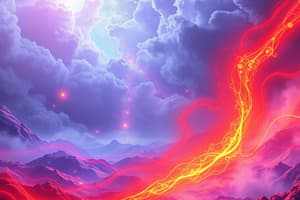Podcast
Questions and Answers
Flashcards
What is heat?
What is heat?
Heat is the form of energy that is transferred between two bodies at two different temperatures when kept in contact.
What is the SI unit for heat?
What is the SI unit for heat?
The S.I. unit of heat energy is the joule (J).
What is temperature?
What is temperature?
Temperature is a quantity that indicates the thermal state of a body. It determines the direction of heat flow when two bodies at different temperatures are placed in contact.
What is the SI unit for temperature?
What is the SI unit for temperature?
Signup and view all the flashcards
What is thermal expansion?
What is thermal expansion?
Signup and view all the flashcards
What are the types of thermal expansion?
What are the types of thermal expansion?
Signup and view all the flashcards
What is linear expansion?
What is linear expansion?
Signup and view all the flashcards
What is superficial expansion?
What is superficial expansion?
Signup and view all the flashcards
What is cubical expansion?
What is cubical expansion?
Signup and view all the flashcards
What is anomalous expansion of water?
What is anomalous expansion of water?
Signup and view all the flashcards
At what temperature does water have the highest density?
At what temperature does water have the highest density?
Signup and view all the flashcards
What is an ecosystem?
What is an ecosystem?
Signup and view all the flashcards
What is a food chain?
What is a food chain?
Signup and view all the flashcards
What are producers?
What are producers?
Signup and view all the flashcards
What are consumers?
What are consumers?
Signup and view all the flashcards
What are decomposers?
What are decomposers?
Signup and view all the flashcards
What are primary consumers?
What are primary consumers?
Signup and view all the flashcards
What are secondary consumers?
What are secondary consumers?
Signup and view all the flashcards
What are tertiary consumers?
What are tertiary consumers?
Signup and view all the flashcards
Why is energy transfer in an ecosystem not 100% efficient?
Why is energy transfer in an ecosystem not 100% efficient?
Signup and view all the flashcards
What is a renewable energy source?
What is a renewable energy source?
Signup and view all the flashcards
What is a non-renewable energy source?
What is a non-renewable energy source?
Signup and view all the flashcards
What is solar energy?
What is solar energy?
Signup and view all the flashcards
What is wind energy?
What is wind energy?
Signup and view all the flashcards
What is hydro energy?
What is hydro energy?
Signup and view all the flashcards
What is nuclear energy?
What is nuclear energy?
Signup and view all the flashcards
What is the greenhouse effect?
What is the greenhouse effect?
Signup and view all the flashcards
What are greenhouse gases?
What are greenhouse gases?
Signup and view all the flashcards
What is global warming?
What is global warming?
Signup and view all the flashcards
Study Notes
Exercise 6(A) - Multiple Choice Type
- Heat energy flows from hot to cold bodies
- Calorie is a unit of heat
- 1 Joule = 0.24 calories (approximately)
- 1 Joule = 107 erg
- Temperature determines the direction of heat flow
- The amount of heat energy in a body depends on its mass, temperature and the nature of the material.
- The SI unit of temperature is Kelvin (K).
- The relation between Celsius and Kelvin scales is tK = 273 + t°C
- The temperature of a body is related to the average kinetic energy of its molecules.
- The temperature at which pressure and volume of a gas becomes zero is 0 K.
- The steam point on the Fahrenheit scale is 212°F.
- The increase in the length of a solid on heating is called linear expansion.
- Liquids expand more than solids and gases expand more than liquids when heated.
- Water expands when cooled from 4°C to 0°C. This is known as anomalous expansion.
- The density of water is maximum at 4°C, with a value of 1000 kg m-3.
- Ice is a poor conductor of heat, acting as an insulator.
Exercise 6(A) - Very Short Answer Type
- Heat is the form of energy transferred between two bodies at different temperatures. The SI unit of heat is Joule (J).
- Heat flows from a hotter body to a colder body.
Exercise 6(B) - Multiple Choice Type
- Trees are a biotic component of an ecosystem.
- Light, heat, and rain are abiotic components.
Exercise 6(B) - Very Short Answer Type
- An ecosystem is a unit comprised of biotic (living organisms) and abiotic (non-living factors) components.
- A food chain is a linear sequence of organisms where each organism feeds on the previous one, illustrating the flow of energy.
Exercise 6(B) - Short Answer Type
- The sun is the primary source of energy for all ecosystems.
- Green plants are crucial to ecosystems as they produce food through photosynthesis, using sunlight as energy.
Exercise 6(C) - Multiple Choice Type
- The ultimate source of energy is the sun.
- Renewable sources of energy can be continuously obtained over a long period of time.
- Kinetic energy is associated with the movement of an object.
- The solar constant is 1.34 kW m-2.
- The correct renewable sources of energy are biomass and nuclear fuel.
- Geothermal energy originates from the heat within the Earth.
Exercise 6(C) - Very Short Answer Type
- Characteristics of a good energy source include consistent supply and safe use.
- Renewable resources, like wood and water, can be replenished, while non-renewable resources, like fossil fuels, cannot.
Exercise 6(C) - Short Answer Type
- The conversion of energy from one form to another often results in some energy becoming unusable (e.g., heat).
- Solar cells convert light energy directly into electrical energy.
- Solar power plants use mirrors to concentrate sunlight to heat water and produce steam, which then drives turbines to generate electricity.
- Advantages of hydroelectricity include its clean source and renewing nature. Disadvantages include environmental impacts from dam construction.
- Nuclear energy has high-energy output from a small amount of fuel but comes with the risk of radioactive waste.
- Four ways to use energy judiciously are efficient energy use, utilizing renewable sources, protecting forests, and responsible population control.
Exercise 6(D) - Multiple Choice Type
- The gases that absorb long-wavelength infrared radiation are called greenhouse gases.
- Carbon dioxide is a greenhouse gas.
- Increased carbon dioxide in the atmosphere leads to increased temperature.
- Without the greenhouse effect, the average temperature of Earth would be -18°C.
- Global warming means a rise in average global temperatures due to increased greenhouse gases.
Exercise 6(D) - Short Answer Type
- The increase in carbon dioxide in the atmosphere is primarily due to human activities, like burning fossil fuels, deforestation, and manufacturing.
- Greenhouse gases like carbon dioxide and methane trap heat in the Earth's atmosphere, causing global warming.
- Ways to minimize the impact of global warming include transitioning to renewable energy sources, using more energy-efficient vehicles and practices, controlling population, and reducing wasteful energy consumption.
Studying That Suits You
Use AI to generate personalized quizzes and flashcards to suit your learning preferences.




